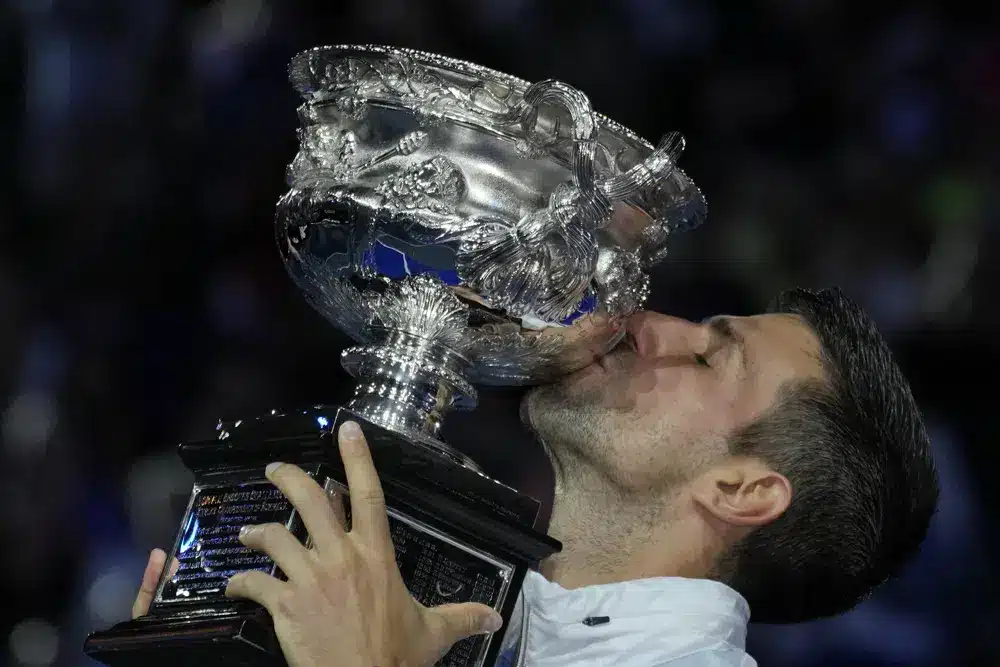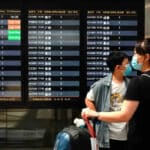MELBOURNE, Australia – Novak Djokovic climbed up into the stands at Rod Laver Arena on Sunday to celebrate winning his 10th Australian Open and 22nd Grand Slam title. He then fell on his back and started crying.
Djokovic sat on his sideline bench, buried his face in a white towel, and sobbed when he returned to the playing surface.
This trip to Australia was far more successful than the one a year ago when he was deported because he had not been vaccinated against COVID-19, though it was difficult in its way: a hamstring injury, some off-court quarrels with his father. Nonetheless, Djokovic accomplished everything he could have hoped for in his comeback: he resumed his winning ways at Melbourne Park and returned to the top of the tennis world, declaring: “This probably is the biggest victory of my life.”
Stefanos Tsitsipas gave Djokovic a short run for his money in the final, but Djokovic beat him 6-3, 7-6 (4), 7-6. (5). As a bonus, Djokovic will rise from No. 5 to No. 1 in the ATP rankings, a position he has already held for more weeks than any other player.
“Considering the circumstances, this has been one of the most difficult tournaments I’ve ever played. “I didn’t play last year; I’m back this year,” Djokovic said, wearing a white zip-up jacket with a “22” on the chest. “I also want to thank everyone who made me feel welcome and comfortable in Melbourne and Australia.”
The 35-year-Old Serb Won His 28th Straight Match In Australian Open.
The 35-year-old Serb won his 28th straight match in Melbourne, making it the longest unbeaten streak in Australian Open history (since 1968). He now has ten trophies, including seven from Wimbledon, three from the US Open (where he was also absent last year due to a lack of coronavirus shots), and two from the French Open, matching rival Rafael Nadal for the most by a man.
Only two women are ahead of him: Margaret Court (24) and Serena Williams (23).
This was also Djokovic’s 93rd ATP tour-level title, breaking a tie with Nadal for fourth-most.
“I’d like to thank you for advancing our sport so far,” Tsitsipas said to Djokovic.
“He is the greatest that has ever held a tennis racket,” Tsitsipas said.
Djokovic was competing in his 33rd major final, while Tsitsipas was competing in his second — and the 24-year-old Greek also lost the other, at the 2021 French Open, to Djokovic.
Djokovic was superior throughout, especially in the two tiebreakers, on a cool evening under a cloudy sky, with a soundtrack of chants from both men’s supporters prompting repeated pleas for quiet from the chair umpire.
He took a 4-1 lead in the first quarter and scored the final three points. He led 5-0 in the final tiebreaker, and when it was over, he screamed and pointed to his temple, a precursor to all of the tears.
An Emotional Week For All In Attendance
“It was very emotional for us. “It was very emotional for him,” Djokovic’s coach, Goran Ivanisevic, said. “It’s a fantastic accomplishment. He had a very difficult three weeks. He was able to triumph over all odds.”
Djokovic admitted that all of the issues were stressful for him.
“It took enormous mental and emotional energy to keep it tight, keep my focus,” Djokovic said.
Keep in mind that, aside from a rash of early miscues that resulted in more tension than anything else, Tsitsipas didn’t play all that poorly. It’s because Djokovic was too rigid. Because he was too careful with his shots, he only made 22 unintentional mistakes, which was 20 less than his opponent. On the run, you need to be more quick and adaptable (other than when, moving to his left, Djokovic took a tumble).
“I tried everything,” said Tsitsipas, who would have moved to No. 1 with a win, replacing Carlos Alcaraz, who missed the Australian Open due to a leg injury.
Perhaps. Djokovic, on the other hand, keeps pushing until his opponent misses or gives him a chance to take advantage.
The Come-Back Kid
That happened when Tsitsipas saved his first break point, also a set point, with Djokovic serving at 30-40 in the second set. Could this be a fulcrum? Could Djokovic give in? Could Tsitsipas make a comeback?
Djokovic finished a 15-stroke point with a cross-court forehand winner that felt like a statement. Tsitsipas then missed two shots: a backhand long and a forehand wide. Those felt like surrender. Even when Tsitsipas broke in the third, Djokovic broke right back.
Over the last two weeks, Djokovic has been thinking about more than just forehands and backhands.
There was also the not-insignificant matter of last year’s legal saga — he has alternately acknowledged the whole thing served as a form of motivation but also said the other day, “I’m over it” — and apprehension about the kind of reception he would receive if he were allowed to enter Australia because pandemic restrictions had been relaxed.
Constant Heckling At The Australian Open
He got a lot of loud support, but he also had to deal with constant heckling, like when people cheered after he made mistakes on Sunday.
There was the sore left hamstring, which had been heavily bandaged for every match — until the final, when only a piece of beige athletic tape could be seen.
After Djokovic’s quarterfinal, his father, Srdjan, was filmed with a group waving Russian flags, one with an image of Vladimir Putin on it. The tournament prohibited spectators from carrying Russian or Belarussian flags, claiming they would disrupt due to Ukraine’s ongoing invasion. According to Djokovic and his father, Srdjan thought he was with Serbian fans.
Srdjan Djokovic, however, did not attend his son’s semifinal or final.
“We both agreed,” said the younger Djokovic, who did meet up with his father for a hug after the match on Sunday, “that it would probably be better if he weren’t there.”
Regardless, Djokovic performed admirably, as he frequently does.
“It’s been a long journey, but it’s been a very special one,” he said.
SOURCE – (AP)












